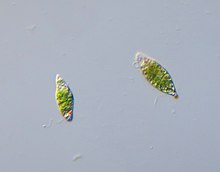
Back يوغلينا Arabic يوغلينا ARZ Эўглена Byelorussian Еуглени Bulgarian Euglena BS Euglena Catalan Krásnoočko Czech Augentierchen German Eŭgleno Esperanto Euglena Spanish
| Euglena | |
|---|---|

| |
| Euglena sp. | |
| Scientific classification | |
| Domain: | Eukaryota |
| Phylum: | Euglenozoa |
| Class: | Euglenida |
| Clade: | Euglenophyceae |
| Order: | Euglenales |
| Family: | Euglenaceae |
| Genus: | Euglena Ehrenberg, 1830 |
Euglena is a genus of single cell flagellate eukaryotes. It is the best known and most widely studied member of the class Euglenoidea, a diverse group containing some 54 genera and at least 200 species.[1][2] Species of Euglena are found in fresh water and salt water. They are often abundant in quiet inland waters where they may bloom in numbers sufficient to color the surface of ponds and ditches green (E. viridis) or red (E. sanguinea).[3]
The species Euglena gracilis has been used extensively in the laboratory as a model organism.[4]
Most species of Euglena have photosynthesizing chloroplasts within the body of the cell, which enable them to feed by autotrophy, like plants. However, they can also take nourishment heterotrophically, like animals. Since Euglena have features of both animals and plants, early taxonomists, working within the Linnaean two-kingdom system of biological classification, found them difficult to classify.[5][6] It was the question of where to put such "unclassifiable" creatures that prompted Ernst Haeckel to add a third living kingdom (a fourth kingdom in toto) to the Animale, Vegetabile (and Lapideum meaning Mineral) of Linnaeus: the Kingdom Protista.[7]
- ^ "The Euglenoid Project: Alphabetic Listing of Taxa". The Euglenoid Project. Partnership for Enhancing Expertise in Taxonomy. Archived from the original on February 23, 2017. Retrieved Sep 20, 2014.
- ^ "The Euglenoid Project for Teachers". The Euglenoid Project for Teachers. Partnerships for Enhancing Expertise in Taxonomy. Archived from the original on February 23, 2017. Retrieved Sep 20, 2014.
- ^ Wolosski, Konrad (2002-04-25). "Phylum Euglenophyta". In John, David M.; Whitton, Brian A.; Brook, Alan J. (eds.). The Freshwater Algal Flora of the British Isles: an Identification Guide to Freshwater and Terrestrial Algae. Cambridge University Press. p. 144. ISBN 978-0-521-77051-4.
- ^ Russell, A. G.; Watanabe, Y; Charette, JM; Gray, MW (2005). "Unusual features of fibrillarin cDNA and gene structure in Euglena gracilis: Evolutionary conservation of core proteins and structural predictions for methylation-guide box C/D snoRNPs throughout the domain Eucarya". Nucleic Acids Research. 33 (9): 2781–91. doi:10.1093/nar/gki574. PMC 1126904. PMID 15894796.
- ^ Margulis, Lynn (2007). "Power to the Protoctists". In Margulis, Lynn; Sagan, Dorion (eds.). Dazzle Gradually: Reflections on the Nature of Nature. White River Junction: Chelsea Green. pp. 29–35. ISBN 978-1-60358-136-3.
- ^ Keeble, Frederick (1912). Plant-animals: a study in symbiosis. London: Cambridge University Press. pp. 103–4. OCLC 297937639.
- ^ Solomon, Eldra Pearl; Berg, Linda R.; Martin, Diana W., eds. (2005). "Kingdoms or Domains?". Biology (7th ed.). Belmont: Brooks/Cole Thompson Learning. pp. 421–7. ISBN 978-0-534-49276-2.